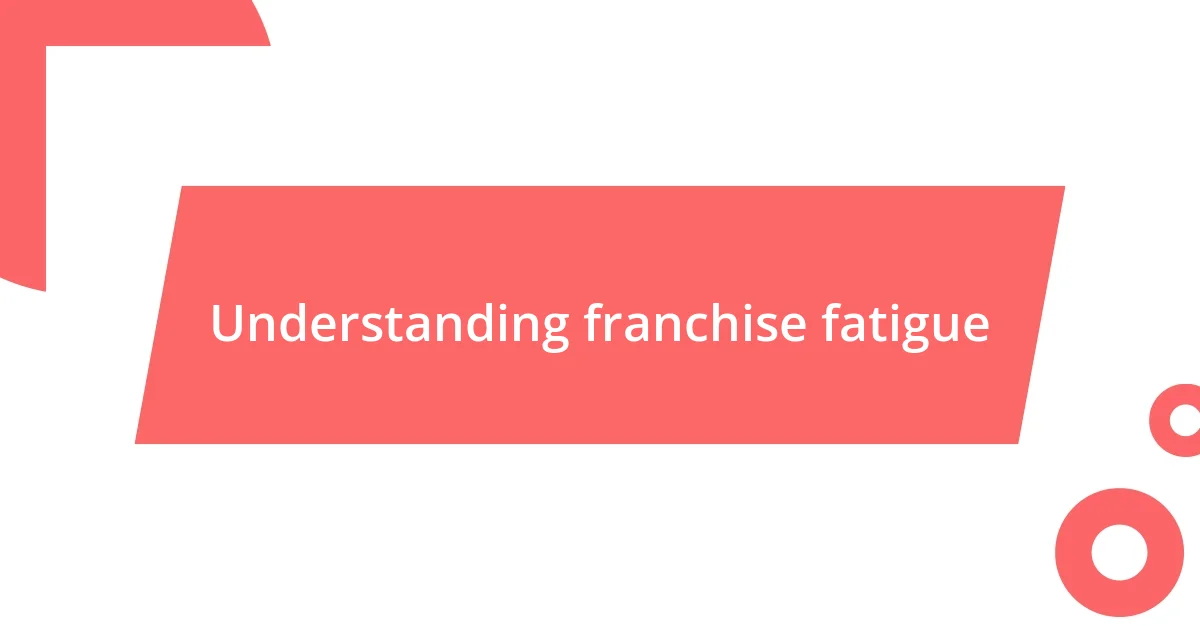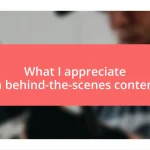Key takeaways:
- Franchise fatigue arises from repetitive content, lack of innovation, and disconnection from fan expectations, leading to diminished enthusiasm and community engagement.
- Key signs of franchise fatigue include repetitive plotlines, decreased sales, negative reviews, and dwindling fan interactions, creating a feedback loop of waning interest.
- To combat fatigue, franchises should innovate while respecting their roots, pace releases to build anticipation, and actively engage the community for feedback and involvement.

Understanding franchise fatigue
Franchise fatigue can feel like a slow burn, creeping in after a series of similar storylines, characters, and gameplay mechanics. I remember the excitement I felt during the release of the first few games in a popular series, but as they continued to churn out new titles, I found myself asking, “Am I really that interested anymore?” It became clear that the novelty had worn off, leaving only a sense of obligation to keep up rather than genuine enthusiasm.
Often, franchise fatigue stems from a lack of innovation. It can be disheartening to invest time and money into a product that feels like a rehash of what’s come before. For instance, when I bought the latest entry in a beloved series, I was taken aback by how much it mirrored earlier installments. It prompted a moment of reflection: “Is this really the direction we want to take?” The emotional connection I once had started to dwindle, which made me question whether the franchise still resonated with my interests.
This fatigue isn’t just about boredom; it also taps into a deeper emotional response. There’s something disheartening about watching a beloved franchise stagnate when you feel personally invested in its growth. Have you ever felt that pull, where the creators seem to overlook the very elements that made you fall in love with the franchise? I’ve experienced this firsthand, and it’s left me yearning for a spark of creativity that reignites that initial love.

Signs of franchise fatigue
Franchise fatigue reveals itself through distinct signs that signal a waning interest among fans. For me, one glaring indicator is when I notice a significant drop in community engagement. I recall eagerly browsing forums after the launch of a new installment, but the last time I checked, the discussions felt sluggish and uninspired. It was as if my fellow fans had collectively decided to step back, leading me to wonder if that enthusiasm had simply fizzled out.
Here are some key signs to look out for:
- Repetitive plotlines that lack fresh twists or character development.
- A noticeable decline in sales or viewership compared to previous entries.
- Negative reviews or mixed reactions that dominate online conversations.
- Limited marketing excitement surrounding new releases, leading to a sense of indifference among audiences.
- Fans expressing frustration over creative choices that stray far from original themes or gameplay mechanics.
These elements create a feedback loop, feeding into the growing sense of fatigue that leaves both creators and consumers questioning the path forward.

Causes behind franchise fatigue
Fan expectations play a crucial role in the onset of franchise fatigue. I remember waiting eagerly for a new title only to find it didn’t meet the high hopes I’d built up. It felt like a letdown, disappointing not just because of the product itself, but because the emotional investment didn’t pay off. When creators fail to deliver on what fans are anticipating, it creates a disconnect that can be hard to bridge, leading many to step away from the franchise altogether.
Another significant cause is market saturation. I can think back to a particular genre that seemed overwhelming, with game after game releasing within just months of each other. This endless stream made me wonder, “Do I really need another title right now?” The constant presence of new releases can dilute excitement as it becomes challenging to keep track. Instead of excitement, I found myself feeling a sense of fatigue, drowning in an ocean of options that didn’t seem all that different from one another.
Finally, the rise of digital media has altered our consumption habits, contributing to franchise fatigue. I’ve noticed that with more platforms offering content, I often shift my attention to fresh narratives that break away from established franchises. Streaming channels and indie games provide a wealth of choices that can overshadow long-standing series. The allure of discovery changes how I engage with franchises I once adored, as novelty becomes more appealing than nostalgia.
| Cause | Description |
|---|---|
| Fan Expectations | High hopes can lead to disappointment when new titles fail to resonate. |
| Market Saturation | Oversaturation of releases can lead to fatigue and desensitization. |
| Digital Media Shift | Abundance of fresh content can overshadow traditional franchises, leading to a search for new experiences. |

Impact of franchise fatigue
Franchise fatigue doesn’t just impact sales; it changes the very essence of how we interact with our favorite series. I remember when I used to eagerly anticipate each sequel, but now, there’s a nagging feeling in the back of my mind—is this just the same story recycled? The weariness can be palpable, as fans grapple with the sense that our beloved franchises may have run out of creative steam, leading to a collective sigh rather than excitement.
One notable effect I’ve personally experienced is the shift in community dynamics. It used to be vibrant and buzzing with theories, fan art, and fan fiction. Now, it feels like we’re all part of a fading gallery, with fewer voices contributing to the discourse. Isn’t it disheartening when online spaces once filled with passionate discussions become ghost towns? This dip in interaction not only dampens my enthusiasm but also raises concerns about the future of storytelling within these franchises.
Moreover, franchise fatigue can breed disillusionment among creators, leading to a vicious cycle. When I look at recent entries that seem forced or uninspired, I can’t help but think, “Are the developers feeling the same exhaustion we are?” It’s a difficult place for both fans and creators to be—while fans seek innovation, creators may feel pressured to stick to familiar formulas. Ultimately, this disengagement can sap the joy out of what was once a thrilling experience, leaving me to wonder if the magic can ever be recaptured.

Solutions to combat franchise fatigue
A practical approach to combatting franchise fatigue is to innovate while respecting established narratives. I’ve found that when creators introduce significant changes—be it a new gameplay mechanic or a fresh storyline—it reignites my interest. Think about how revitalizing a beloved character or incorporating unexpected elements can transform the experience. It’s like when I first encountered a remastered version of a classic game; the thrill was back simply because it felt fresh while still paying homage to its roots.
Another effective solution lies in pacing releases. I appreciate franchises that take a step back rather than bombarding fans with sequels year after year. It allows time for the creative team to develop richer content and keeps fans excited for what’s next. When I reflect on a particular series that embraced slower development, I realize how each installment felt like an event, something worth anticipating instead of just another title in an endless lineup.
Lastly, engaging the community can breathe new life into a franchise. When creators seek feedback and involve fans in discussions about direction, it creates a sense of ownership. I remember feeling empowered when a developer solicited player input for new features; it turned my fatigue into enthusiasm. This collaborative approach not only enriches the experience but also fosters deeper connections between fans and creators, ultimately rejuvenating the franchise itself.

Future of franchises
When I think about the future of franchises, I can’t help but wonder how they will evolve in response to the growing fatigue among fans. It seems like a pivotal moment, where franchises could either double down on repetitive formulas or embrace bold innovations. Personally, I envision a landscape where creators bravely experiment, crafting unique narratives that stand apart from the norm.
I’m particularly excited about the potential for franchises to tap into diverse storytelling formats. Whether through multimedia experiences that blend games, movies, and web content, or even interactive formats that let fans shape the story, there’s an incredible opportunity for renewal. I still remember my excitement when I stumbled upon an interactive narrative that let me make choices affecting the plot—it was like being part of the story itself. Could this level of engagement be the key to winning back jaded fans?
However, I worry about franchises losing their identity in the rush to innovate. It’s a balancing act; how do creators stay true to what makes a franchise beloved while also pushing boundaries? I’ve seen some attempts at innovation fall flat because they strayed too far from what attracted me in the first place. If the future is about growth, it must also honor the roots of beloved franchises, allowing for both nostalgia and fresh perspectives.

Conclusion on franchise fatigue
Franchise fatigue is a complex phenomenon that reflects a deeper relationship between creators and their audiences. I often find myself torn between excitement for new releases and the nagging feeling of déjà vu when a sequel feels like a rehash of previous entries. This ongoing cycle can lead fans, like myself, to question what’s next when the magic starts to wane.
Reflecting on my experiences, I recall moments of true delight when franchises take bold steps to reinvent themselves. For instance, when a beloved series introduced a new character who redefined its central dynamics, I was genuinely surprised and reengaged. It’s these moments of unpredictability that remind me why I fell in love with the franchise in the first place. Shouldn’t every installment strive to recapture that initial spark?
Ultimately, the conversation around franchise fatigue emphasizes the need for a thoughtful balance between innovation and familiarity. I believe that the most beloved franchises can thrive not by clinging to their past, but rather by understanding what made them special and boldly reimagining those elements. As fans, we crave not just content, but also connection—when a franchise acknowledges our appetite for change while respecting its roots, it can transform exhaustion into excitement.















